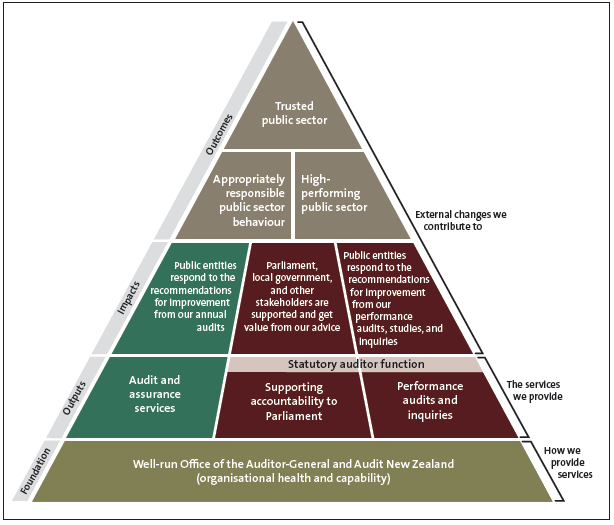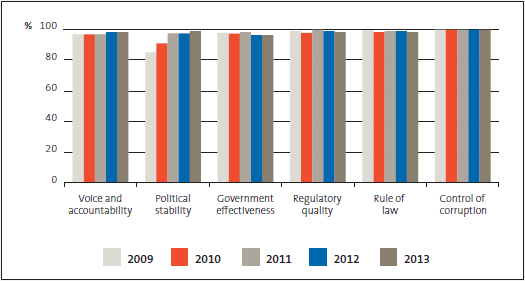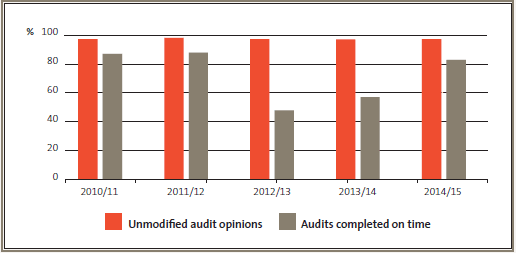Part 1: Our role and outcomes
Everything we do is about improving the performance of, and the public's trust in, the public sector.
Our role
The Auditor-General is an Officer of Parliament who carries out her role independently of executive government and Parliament, but is accountable to Parliament for the public resources she uses to do her job. By law, the Auditor-General audits all public entities in New Zealand that are required to prepare general purpose financial reports – about 3800 public entities, such as government departments, Crown entities, schools, and State-owned enterprises. The role includes auditing local authorities, which are accountable to the public for the activities that they fund with rates and other revenue.
The Auditor-General's audits give independent assurance to Parliament and the public about how public entities are performing. Auditing and reporting on the results of those audits is an important way of holding public entities accountable for their use of public resources and powers.
Our organisation
Our work is carried out by about 391 full-time equivalent staff in two business units – the Office of the Auditor-General (OAG) and Audit New Zealand – supported by a shared team of corporate services staff. We also contract auditors from about 50 private sector accounting firms to carry out some annual audits on the Auditor-General's behalf. We call this whole organisation "the Office".
The OAG sets strategy, policy, and standards, appoints and oversees auditors, carries out performance audits, provides reports and advice to Parliament, and carries out inquiries and other research.
Audit New Zealand, the larger of the two business units, has offices in seven cities and carries out annual audits of public entities that the Auditor-General allocates to it. Audit New Zealand provides other assurance services to public entities within the Auditor-General's mandate, consistent with the Auditor-General's auditing standard on the independence of auditors.
How we are funded
The Office is funded through Vote Audit, which has two appropriations for our output expenses – Audit and assurance services and the multi-class appropriation Statutory auditor function.1
The appropriation for Audit and assurance services pays for us to carry out audits and related assurance services as required or authorised by law, and is largely funded by audit fees collected directly from public entities.
The multi-class appropriation Statutory auditor function is largely Crown-funded and includes two classes of outputs: Performance audits and inquiries, and Supporting accountability to Parliament.
How we make a difference
In carrying out our statutory role, we are able to play an important part in influencing and promoting improvements in the public sector's performance and in building trust in the public sector.
The main impacts we aim for are that our recommendations are acted on, and that Parliament and public entities are supported and get value from our advice.
Our vision
Our vision is that our work improves the performance of, and the public's trust in, the public sector. Everything we do is directed at ensuring that New Zealand has a public sector that is trusted, demonstrates responsible behaviour, and performs well. The rest of this report outlines how effectively we worked towards these outcomes during 2014/15.
The outcomes we aim for
Figure 1 summarises the outcomes we aim for, the effects we aim to have, and the services that we provide.
Figure 1
Our outcomes framework


Achieving the outcomes we aim for
We assess that, in 2014/15, our outcomes were mostly maintained or improved.
| Trusted public sector | |
|---|---|
| Measure | New Zealand's ranking in or above the 90th percentile of the Worldwide Governance Indicators is improved (or at least maintained).* |
| Result | Achieved in 2013. |
| Comment | Results for the Worldwide Governance Indicators are usually published every September for the previous calendar year – 2014 results are not yet available. |
| Figure 2 New Zealand's ranking in the Worldwide Governance Indicators, 2009 to 2013  |
|
| Measure | The State Services Commission's Kiwis Count Survey** shows improved (or at least maintained) rates of:
|
| Result | Achieved. |
| Comment | For this measure, respondents rate their perceptions of trust in the public service and their trust based on their most recent public service experience. The responses have been reported quarterly since June 2012. From June 2012 to September 2014, perceptions of trust in the public service improved overall (42% in June 2012 to 45% in September 2014). Trust based on experience also improved overall (74% in June 2012 to 77% in September 2014). |
* See the World Bank website, http://info.worldbank.org/governance/wgi/.
** For survey results, contact the State Services Commission, www.ssc.govt.nz.
| Measure | New Zealand's score on the Transparency International Corruption Perceptions Index* is improved (or at least maintained). |
| Result | Achieved. |
| Comment | In 2014, New Zealand maintained its 9.1 score from the previous year. However, New Zealand's world ranking dropped from first equal with Denmark to second. From 2010 to 2014, New Zealand's score has consistently been between 9.0 and 9.5. |
* See the Transparency International website, http://www.transparency.org/cpi2014.
| Appropriately responsible public sector behaviour | |
|---|---|
| Measure | Public sector behaviour is more responsible in the area of accountability for public resources |
| Result | Achieved |
| Comment | Holding public entities accountable for their use of public resources is a fundamental part of our work. This new composite measure gives a more comprehensive picture of how well the public sector is accounting for its use of public resources than the measure previously reported. Indicators of responsible behaviour in the area of accountability for public resources include reliable and timely information, sound management and good governance. We examined trends across these aspects of public sector behaviour to assess an outcome for this measure. While it is a mixed picture, overall we are satisfied that public sector behaviour is more responsible in the area of accountability for public resources because trends for timeliness and quality of reporting are steadily improving. Figure 3 illustrates trends across the public sector for timeliness (as indicated by audits completed on time) and reliability of information (as indicated by the issue of unmodified audit opinions). For example, timeliness of audit completion across the public sector has improved. This year, 83% of public entities' audit reports were signed within the statutory time frame, compared to 57% in 2013/14, when ongoing problems with Novopay delayed completion of school audits. Although there were significantly fewer payroll problems than in the previous two years, delayed production of year-end payroll reports resulted in delays for some school audits. We note that, while it is improving, timeliness of audit completion has not yet returned to the levels that were being achieved before the Novopay problems. The percentage of unmodified audit opinions across the public sector remains steady. This year, 97.3% of audit opinions were unmodified, similar to previous years (97.1% in 2013/14 and 97.4% in 2012/13). |
| Figure 3 Percentage of unmodified audit opinions and audits completed on time, 2010/11 to 2014/15  Timely public release of annual reports is also an important part of accountability for public resources. We currently collect data about timeliness of public release only for local authority annual reports. For 2013/14, 92% of local authority annual reports were publicly available on time. Although this is a reduction from 99% in 2011/12 and 96% in 2012/13, we have few concerns about this trend given our knowledge of the factors affecting the performance of the local government sector. We will continue to monitor local authorities' timely public release of annual reports for the year to 30 June 2015. We will also consider whether we need to collect data for other sectors for future reporting. Results for the central government sector (excluding schools) show a mixed picture for management control environment (MCE), financial information systems and controls (FISC), and service performance information and associated systems and controls (SPIASC). Figure 4 shows an improvement in some areas and a decline in others. We have applied particular effort to encouraging the improvement of service performance information, and note the increase in "very good" ratings from 1% in 2010/11 to 9% in 2013/14. |
|
Figure 4
Ratings for central government entities, 2010/11 to 2013/14
| 2010/11 | 2011/12 | 2012/13 | 2013/14 | |
|---|---|---|---|---|
| MCE | ||||
| Very good | 52% | 56% | 62% | 59% |
| Good | 41% | 39% | 32% | 34% |
| Needs improvement | 7% | 5% | 6% | 7% |
| Poor | 0% | 0% | 0% | 0% |
| FISC | ||||
| Very good | 43% | 47% | 52% | 48% |
| Good | 51% | 47% | 45% | 43% |
| Needs improvement | 6% | 6% | 3% | 9% |
| Poor | 0% | 0% | 0% | 0% |
| SPIASC | ||||
| Very good | 1% | 4% | 8% | 9% |
| Good | 52% | 66% | 74% | 73% |
| Needs improvement | 47% | 30% | 18% | 18% |
| Poor | 0% | 0% | 0% | 0% |
| Measure | The State Services Commission's Integrity and Conduct Survey shows improved (or at least maintained) rates of public servants who reported that State service agencies promote their standards of integrity and conduct.* |
| Result | Comparison against the 2013 survey will be possible in 2016. |
| Comment | This survey is held every three years. Changes to the survey mean that the 2013 results are not directly comparable with those from 2007 and 2010. The 2013 survey looked at whether State servants think that their organisation promotes standards of integrity and conduct: 62% of State servants agreed that their agency actively promotes standards of integrity and conduct. The 2007 and 2010 surveys looked at State servants' awareness of their agency's training on integrity and conduct. Results from 2007 (55%) and 2010 (56%) showed that more than half of State servants were aware of integrity training that their organisation provided. |
| Measure | The State Services Commission's Integrity and Conduct Survey shows improved (or at least maintained) rates of public servants who reported that, where they observed misconduct breaches in the past year, they reported it. |
| Result | Survey changes mean that results may not be comparable. |
| Comment | This survey is held every three years. It is scheduled to be held again in 2016. In 2013, changes were made to the survey. The 2013 survey asked whether State servants reported observed misconduct in all instances, in some instances, or not at all.
To the extent that the results are comparable, the survey appears to show that the proportion of State servants reporting observed misconduct has slightly declined from 63% in 2010 to 58% in 2013. |
| High-performing public sector | |
|---|---|
| Measure | The State Services Commission's Kiwis Count Survey shows improved (or at least maintained) rates of service quality for all public services. |
| Result | Achieved. |
| Comment | Results for this measure are collected every quarter. Between June 2012 and September 2014, respondents scored the quality of public services at a consistently high level of at least 72. |
* See the State Services Commission's website, www.ssc.govt.nz.
Strategic risks and risk management
The Auditor-General faces four ongoing strategic risks:
- loss of independence;
- audit failure;
- loss of capability; and
- loss of reputation.
We manage these risks mainly through processes that support the work we do. Details on how we manage these risks are available on our website. We will continue our focus on managing risks, particularly strategic risks. Our leadership teams regularly discuss risk management, including assessing environmental or internal changes that might affect the Office's position. The Office's Audit and Risk Committee usually meets four times a year and gives further insight and advice to help us to identify and manage risk. The Committee's report for 2014/15, available on our website, outlines the Committee's purpose and summarises its work during 2014/15.
1: An appropriation is a parliamentary authorisation to incur expenses or capital expenditure. A multi-class output expense appropriation allows expenses to be transferred between the output classes concerned, without the need for separate Parliamentary authority.

